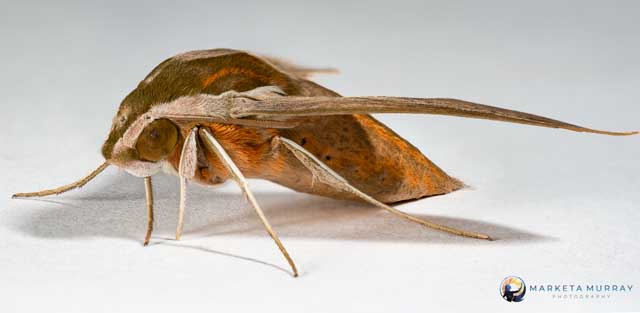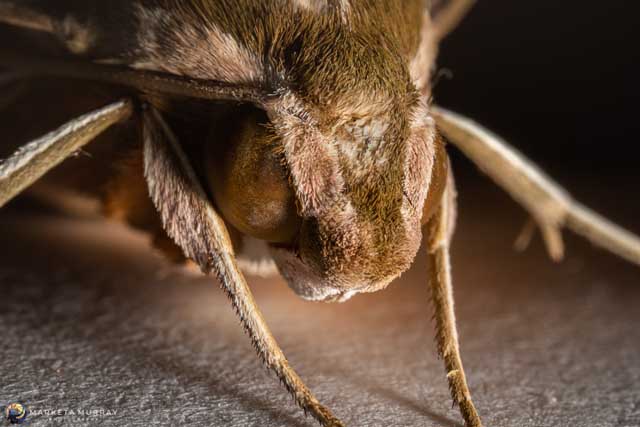Hippotion boerhaviae
|
|
Created as per Topny Pittaway's website, May 18, 2016
Updated as per personal communication with Marketa Murray, Hawaii, December 2, 2021,; December 4, 2021
|
Hippotion boerhaviae
hip-POE-tee-onM roe-ZET-tuh
The Pale Striated Hawkmoth
(Fabricius, 1775) Sphinx boerhaviae

Hippotion boerhaviae male, courtesy of Tony Pittaway

Hippotion rosetta, Mililani, Oahu, Hawaii,
May 2016, courtesy of Elizabeth Spieth.

Hippotion boerhaviae, courtesy of Tony Pittaway
TAXONOMY:
Family: Sphingidae, Latreille, 1802
Subfamily: Macroglossinae, Harris, 1839
Tribe: Choerocampina, Grote & Robinson, 1865
Genus: Hippotion Hubner [1819]...........
Species:boerhaviae (Swinhoe, 1892)
|
Jean Haxaire writes, "Only the dissection could give an absolute and definitive answer distinguishing H. boerhaviae
and H. rosetta. The two sp. are really close."
Ian J. Kitching writes, "I would say that the Hippotion is H. rosetta. The outer margin of the forewing is rather convex, the forewing
postmedian bands are not that well-developed and the hindwing red has an orange tinge (in boerhaviae it is often more pinkish). Furthermore, H. rosetta has
already been recorded in Hawaii, some of the specimens of which were identified by Jean-Marie Cadiou.
"The reference is: Kumashiro, B.R., Heu, R.A., Nishida, G.M. & Beardsley, J.W. 2001. New state records of immigrant insects in the Hawaiian Islands for the
year 1999. Proc. Hawaiian Ent.Soc. 35: 170-184.
"H. rosetta was recorded from Manoa, Honolulu airport (in a cargo container from Taiwan), Oahu (Pawaa, larvae on Boerhaavia). Furthermore, a
specimen was also recorded from Omao, Kauai on November 18 1998, then a new record for Kauai. This was followed by three more at Wailua Homesteads,
Kauai in December 1998 and January 1999."
James Tuttle forwarded the images to Dan Rubinoff who "indicates that H. boerhaviae can be fairly common in Hawaii, but he wasn't at all
confident that the image was boerhaviae."
Based on this communication, I have added both Hippotion boerhaviae and Hippotion rosetta to my checklist for Hawaii.
In early December 2021, I received three images below from Marketa Murray. I believe they are either Hippotion rosetta or Hippotion boerhaviae.
It is difficult to distinguish between the two species even when there is a full view of the forewings. I will also post them on the boerhaviae page.

Hippotion rosetta/boerhaviae, Hawaii, December 2, 2021,
courtesy of Marketa Murray.

Hippotion rosetta/boerhaviae, Hawaii, December 2, 2021,
courtesy of Marketa Murray.

Hippotion rosetta/boerhaviae, Hawaii, December 2, 2021,
courtesy of Marketa Murray.
DISTRIBUTION:
Hippotion boerhaviae (wingspan: 50-68mm)
is known from Sri Lanka, India, Nepal, Thailand, south-eastern China (Hong Kong and Guangdong), Vietnam, Indonesia, the Philippines, eastern Australia and
New Caledonia. It is known to fly long distances and is either an occasional stray, accidental import, or established resident of Hawaii.
Tony Pittaway writes, "Very similar to Hippotion rafflesii rafflesii but distinguishable by paler upperside to the body and forewings and, in western
populations at least, by the buff tornal area of the hindwing upperside. Also very similar to Hippotion rosetta, from which it can be distinguished by the
more elongate and contrastingly patterned forewing uppersides, brighter pink hindwing uppersides and, with certainty, by the shape of the juxta. Underside of
abdomen generally with a well-defined, narrow, pale, median stripe. Forewing upperside very similar to Hippotion rosetta but pattern brighter and more
contrasting, appearing more striped.
"Hindwing upperside with a buff tornal patch; median area brighter pink than Hippotion rosetta."
FLIGHT TIMES AND LARVAL HOST PLANTS:
The larvae mainly feed on Oldenlandia and Spermacoce species. In India, they have been recorded on Impatiens species,
Spermacoce stricta, Spermacoce hispida, Glossostigma spathulatum, Boerhavia repens and Boerhavia diffusa.
The host plant is Pentas lanceolata in Australia. The larvae are green with black and white spots along each side.
The pupa is silvery brown, with a row of black spots along each side.
ECLOSION:
Pupae probably wiggle to surface from subterranean chambers just prior to eclosion.
Larvae probably can occur in at least two forms: green and dark brown.
The following information is from Tony Pittaway's site:
Eggs are "bright green, slightly oval, shiny and smooth (Bell & Scott, 1937)."
Full-fed larvae are "55mm. long, width 8mm., horn 4mm. According to Bell & Scott (1937), in the final instar head round, clypeus equilaterally triangular,
one-half the length of the head. False clypeus forming a fairly broad arch over apex of true clypeus, reaching to two-thirds length of head. Labrum one-half
length of clypeus; ligula longer than labrum, its outline square; cutting-edge of mandible coarsely toothed. Surface of head dull and smooth. Body shaped as in
others of the genus, with dull and smooth surface. Horn straight rather short and thin, tapering gently to a blunt tip, minutely tuberculate (Bell & Scott, 1937)."
"In colour, head greyish, with an olive-green tinge. Labrum glassy-white; ligula opaque-white; basal segment of antenna white, other segments reddish; mandible white,
tip black. Body greyish tinged with olive-green; segments 6 to 12 with a number of short dark lines across each secondary ring, except on venter. There is a narrow
blue dorsal stripe, and a narrow pinkish dorso-lateral stripe on segments 2 to 4 and from segment 11 to base of horn and thence to tip of anal flap. There is also a
greyish subspiracular stripe, broad and well defined on 2 to 5, then narrower and ill-defined to 12. A dorso-lateral, rounded eye-spot is present on segment 5, its
pupil with the lower half black, shading into rusty in the upper half, in which there is a line of coalescent white dote; the whole edged broadly above, narrowly
below with yellow and ridged with black. There are smaller eye-spots on 6 to 11, decreasing in size backwards; pupils yellow shading to rusty above, ringed narrowly
with black. All the eye-spots have a small crescent of pale blue above the upper edge. There is also a small round, subdorsal yellow spot mesially on 6 to 11, and a
round blue supra-spiracular spot on the same segments. Horn with base pinkish, middle black, tip white; legs pink; venter sparsely dotted with white
(Bell & Scott, 1937)."
Use your browser "Back" button to return to the previous page.
This site has been created by Bill Oehlke.
Comments, suggestions and/or additional information are welcomed by Bill.
Enjoy one of nature's wonderments: Live Saturniidae (Giant Silkmoth) cocoons.
 | 
Show appreciation for this site by clicking on flashing butterfly to the left.
The link will take you to a page with links to many insect sites. |







